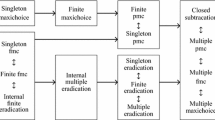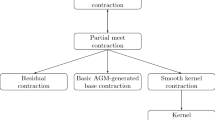Abstract
When a belief set is contracted only some beliefs are eligible for removal. By introducing eligibility for removal as a new semantic primitive for contraction and combining it with epistemic entrenchment we get a contraction operator with a number of interesting properties. By placing some minimal constraint upon eligibility we get an explicit contraction recipe that exactly characterises the so called interpolation thesis, a thesis that states upper and lower bounds for the amount of information to be given up in contraction. As a result we drop the controversial property of recovery. By placing additional constraints on eligibility we get representation theorems for a number of contraction operators of varying strength. In addition it is shown that recovery contraction is a special case that we get if eligibility is explicitly constructed in terms of logical relevance.
Similar content being viewed by others
References
AlchourrÓn, C., P. GÄrdenfors, and D. Makinson, ‘On the logic of theory change: Partial meet functions for contraction and revision’, Journal of Symbolic Logic, 50:510–530, 1985.
Cantwell, J. ‘Some logics of iterated revision’, Studia Logica, 7:49–84, 1999.
Cantwell, J. Non-linear belief revision, Acta Universitatis Upsaliensis, Uppsala, Sweden, 2000.
Darwiche, A. and J. Pearl, ‘On the logic of iterated belief revision’ Artificial Intelligence, 89:1–29, 1997.
FariÑas Del Cerro, L. and A. Herzig, ‘Belief change and dependence’, in Y. Shoham (ed.), TARK'96, pp. 147–162, Morgan Kaufmann Publishers, 1996.
GÄrdenfors, P., ‘Belief revision and irrelevance’, PSA, 2:349–356, 1990.
GÄrdenfors, P. and D. Makinson, ‘Revisions of knowledge systems and epistemic entrenchment’, in M. Y. Vardi (ed.), Proceedings of the Second Conference on Theoretical Aspects of Reasoning about Knowledge, pp. 83–95, Morgan Kaufmann, Los Altos, 1988.
Hansson, S. O., ‘In defense of base contraction’, Synthese, 91:239–245, 1992.
Hansson, S. O., ‘Changes on disjunctively closed bases’, Journal of Logic, Language and Information, 2:255–284, 1993.
Hansson, S. O., ‘Taking belief bases seriously’, in D. Prawitz and D. Westerstahl (eds), Logic and Philosophy of science in Uppsala, pp. 13–28, Kluwer Academic Publishers, The Netherlands, 1994.
Hansson, S. O., A Textbook of Belief Dynamics, Kluwer, 1999.
Rott, H., ‘Preferential belief change using generalised epistemic entrenchment’, Journal of Logic, Language and Information, 1:45–78, 1992.
Rott, H. and M. Pagnucco, ‘Severe withdrawal (and recovery)’, Journal of Philosophical Logic, 28:501–547, 1999.
Shoham, Y., Reasoning about change — Time and causation from the standpoint of Artificial Intelligence. The MIT press, Cambridge, Massachusetts, 1988.
Author information
Authors and Affiliations
Rights and permissions
About this article
Cite this article
Cantwell, J. Eligible Contraction. Studia Logica 73, 167–182 (2003). https://doi.org/10.1023/A:1022975611979
Issue Date:
DOI: https://doi.org/10.1023/A:1022975611979




